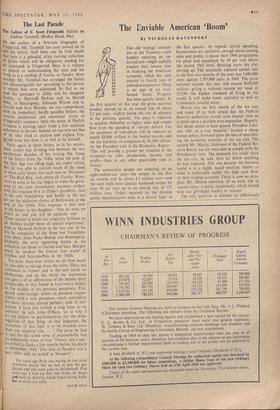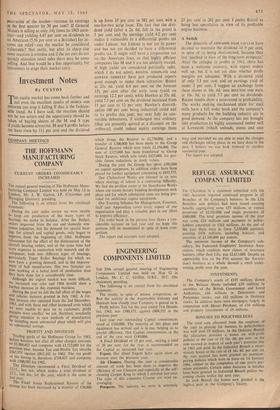The Enviable American 'Boom'
By NICHOLAS DAVENPORT
THE old `stop-go' control- lers at the Treasury-now happily enjoying an en- forced rest-might usefully employ their leisure time in studying the American economy, which has now entered its fourth }ear of unbroken expansion. There is no sign of an over- heated boom. Progress has been quietly steady. In the first quarter of this year the ,gross national product moved up at an annual rate of about 5.2 per cent-slightly below the rate of advance in the previous quarter. The pace is expected to quicken thereafter as higher sales and output flow from the spending of `tax-cue dollars. The tax payments of individuals will be reduced by nearly $8,800 million in the twelve months and the tax liabilities of companies by $1,500 million. As the President said in his Economic Report: 'This will provide a greater net stimulus to the economy-to jobs, production, income and profits-than in any other peace-time year in history.'
The automobile people are counting on an eight-million-car year-the output in the first six months will be about 4.3 million cars-and the steel mills have already increased, output by over 10 per cent up to an annual rate of 125 million tons. Orders received by the durable goods manufacturers were at a record 'high' in
the first quarter. As regards capital spending, businessmen are optimistic enough about coming sales and profits to boost their 1964 programme for plant and equipment by 10 per Cent above the record 1963 level. Housing starts are also moving up. The seasonally adjusted annual rate in the first two months of the year was 1,686,000 units against 1,587,000 units in 1963. The gross national income this year will exceed $630,000 million-giving a national income per head of $3,330-the highest standard of living in the world. It will make many capitalist as well as Communist mouths water.
March was the first month of the tax cuts and many of us were afraid that the Federal Reserve authorities would raise interest rates as a check upon a possible over-expansion. Happily, this threat seems to have passed. President John- son, who, as a true 'populist,' favours a cheap money policy, frowned upon the idea of neutralis- ing the economic stimulus of the tax cuts. The austere Mr. Martin, chairman of the Federal Re- serve Board, was for once able to comply with the Presidential view. The demands for credit since the tax cuts, he said, were far below anything, he had expected. This was because the business world is in a highly liquid position, thanks to what is technically called 'the high cash flow' of their trading accounts. There is now no pros- pect, Mr. Martin admitted, of an early rise, in interest rates-a point, incidentally, which should help our gilt-edged market to recover.
The only question is whether an inflationary
situation will develop later in the year as a result of wage negotiations in several important industries--clothing, machinery, transportation and motors—whose contracts run out or can be re-opened in 1964. The United Automobile Workers are demanding substantial rises in wages and fringe benefits. Mr. Walter Heller, the Presi- dent's chief economic adviser, who is no de flationist, has recently stressed the importance of keeping wage increases close to the 3.2 per cent average gain in productivity of the past five years. The President told members of the UAW in a speech at Atlantic City in March 'We must not choke off our needed and speedo economic expansion by a revival of the wage- price spiral.'
Up to date, the American economy has had as the President added, 'a good record of price stability.' Wage increases have been offset bY rising productivity, so that unit labour costs have been kept steady. The bigger volume of output has enabled both wages and profits to make considerable gains. A price-stabilising fac- tor has been the big growth in the labour force —1,400,000 in the past twelve months. The ex- pansion in jobs has been strong enough not only to absorb this increase, but to reduce unem ployment by 300,000, which has brought the seasonally adjusted unemployment rate down to 5.4 per cent. This is still high by our standarda, but it does not seem to worry the Americana Mr. Walter Heller has predicted that it will droll) to 5 per cent or below by the end of the yeat, but there is little chance that it will fall to the target level of 4 per cent by the end of 1965 However, as long as the numbers employed— now over 73,000,000—keep slowly rising, Presi dent Johnson is not likely to lose face on the failure of his administration to achieve full em ploymen t.
At the moment, the President is gaining credit for his economy drive—seen in Mr. McNamara's cutting of the overseas defence bill—which has enabled the deficit in the balance of payments to be greatly reduced. Mr. Dillon, the Secretary of the Treasury, has just revealed that the deficit fell to an annual rate of about $1,250 million in the first quarter of the year against $3,300 million in 1963. If temporary short-term capital outflows are excluded, the accounts, he said, were 'approximately in balance.' The only threat is the increase in American bank loans overseas through the Euro-dollar market. If President Johnson can stop this leak he might do without his predecessor's proposed 'equalisation' tax on foreign securities.
Wall Street continues to forge ahead quietly but steadily without exciting too much com- ment. Unlike Kennedy, President Johnson is the Street's ideal man at the White House. They feel that he is pro-business, pro-profits and pro- 'market. Kennedy had destroyed market confi- dence in 1962 by his attack on steel prices and profits. Johnson has restored market confidence by getting the Tax Bill into law, by settling the threatened rail strike, by cutting expenditures and by declaring war on poverty. Under the Ken- nedy attack the Dow Jones index of industrial shares had fallen from a high of 734 in late 1961 to a low of 535. At this level the market was valuing the average share at only 14.7 times 1962 earnings. This was too low and the strong recovery which followed has carried the index up to 827, at which level it is valuing the average share at about twenty times 1963 earnings cr 18.4 times the estimated earnings for 1964 (allowing for an 8 per cent increase). This is not unreasonable. Did not General Motors—the Pace-setter of the market—increase its earnings in the first quarter by 30 per cent? U General Motors is selling at only 141 times its 1963 earn- ings—and yielding 4.45 per cent on dividends to an American (5.56 per cent to a Britisher) for in- come tax relief—can the market be considered vulnerable? Not really, but after its sharp rise some reaction is overdue and if the tax cuts do not quickly stimulate retail sales there may be some selling. And that would be a fine opportunity for latecomers to stage their market entry.
































 Previous page
Previous page